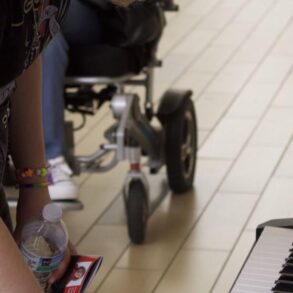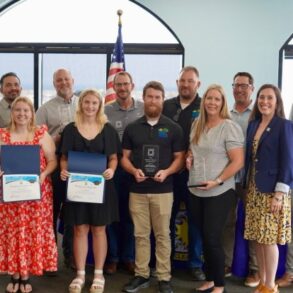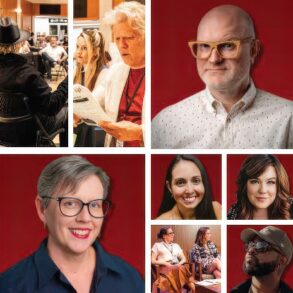The Business of Creating Art Through Sound
Linguists estimate that the average adult will hear 30,000 unique words in every 24-hour period.
“What makes audio unique is that it can be taken in as you’re doing other things, like driving, mowing the lawn, housework, resting,” says chief audio engineer Kerry Johnson, who works for Plymouth-based Studio 120 — a subsidiary company of The ADS Group. “And for people with limited vision, audiobooks and podcasts are a godsend.”
Johnson’s personal motto is Audio, video, disco—and that’s not referring to recorded pop tunes like the Bee Gees. Latin for “I hear, I see, I learn,” the phrase has guided the longtime audio aficionado in his prolific career since 1975. Since moving from New York to Los Angeles to Big Sky, Montana, to the Twin Cities, he’s worked with reputable clients including Penguin Random House, Medtronic, Pearson, and Glencoe Publishing Co.—creating audiobooks, radio commercials, podcasts, and educational assessments. No matter the client, Johnson’s small-town approach in the big cities and beyond is to ensure every project is unique, accurate, and offers superior sonic quality.
So how do businesses and organizations—looking to make their messages matter—ensure their target audiences are listening? Ahead, Johnson shares five ways to ensure an audio project stands out, tapping into regional resources and the power of human connection.Select a standout narrator.
Consistency, expressiveness, breathing, enunciation—these characteristics, along with a terrific voice, can be tough to find when working on various audio projects. Thankfully, the Twin Cities is rich with voice talent, Johnson says. Minnesota is home to the highest number of live theaters per capita in the U.S., with more than 400 live stages where musicians, comics, actors, and dance troupes perform nearly every evening. Besides local actors, Johnson often taps local radio talent—from Minnesota Public Radio (MPR) to WCCO—to find the right person for each project. “Those people normally are very good at storytelling because they’re live on the air, so they can think on their feet,” Johnson says.
Tap into native language experts.
A few years ago, when Medtronic came to Studio 120 with a multimedia project that required 38 different language translations—including English, Spanish, German, Italian, Polish, Czech, Filipino, Chinese, Mandarin, and Cantonese—Johnson rolled up his sleeves and knew what to do. Not only do foreign-language translations in audio projects have to be accurate, but they have to sound authentic to the regional dialect—tidy distinctions are key. “I found a person for every language, brought them in the studio, and had them record it,” Johnson says. “Then I had another person proof it, and then we sent it off to Medtronic.” Johnson often taps into language experts from local universities, such as Macalester College, the University of St. Thomas, the University of Minnesota, and St. Catherine’s University. A separate project called for verbal instructions in Greek for a Greece-based car wash, so Johnson tapped a local professor from the University of Minnesota. “He was really tickled,” Johnson recalls. “He says, ‘You think my friends in Athens will hear me?’ …. This kind of work puts you in touch with so many different talented people of different countries and persuasions.”

Accuracy is a non-negotiable.
As Johnson once listened to the narrator of a book by one of his favorite authors, he internally cringed when he heard the narrator mispronounce the Minnesota cities of Wayzata and Edina. In his own work, he avoids similar errors by going so far as to call local tourism agencies, businesses, organizations, and sources directly to double-check pronunciations and make sure they’re 100 percent correct. This is especially important in the case of technical, scientific projects, such as one Johnson produced for the University of Minnesota’s pharmacy department. “We had to record thousands and thousands of drug names—long names,” he recalls. He called up the head of the pharmacy school and brought him into the studio, alongside a choice narrator from MPR, who would parrot pronunciations from the pharmacist into the microphone. Then came the extensive proofing process, checking each sound bite was accurate and clear. Johnson, like most editors, takes great pleasure in spotting errors within his own work so that he can fix them—and sometimes even re-record a clip—before sending the final, perfected version to an eager client. “Proofing is a big thing we do much better than a lot of other places,” he says. “[Those studios record] it, and then they send it. They don’t even listen to it again.”
Editing is easier when you do it right the first time.
When Johnson first started his career in the audio profession, he edited using a grease pencil, razor blade, and tape. “When it [transitioned] to digital, it became so much easier because you could try it and, if you didn’t like it, undo it,” Johnson says. While advancements in editing software and technology have made it so technicians can tweak, edit, and change almost anything about a recording, Johnson still uses the do-it-right-the-first-time approach he learned so long ago, ensuring the resulting project sounds authentic, personable, clean-cut, and accurate without time-consuming rounds of back-and-forth editing that still result in choppy audio. Often, he’ll receive requests to edit the audio almost how a text editor can make multiple tweaks to copy without a problem. He reminds clients that audio edits can cause weird inflections, resulting in an unnatural-sounding clip. It’s always best, Johnson says, to iron out those edits prior to recording.
Prioritize the power of the human touch.
“Spoken language has a rhythm and a flow that is distinctly and innately human. And I don’t think you’ll be able to [replicate] it, no matter how good AI gets.” – Kerry Johnson, chief audio engineer
Johnson was reminded of the importance of the human touch when he accepted a cold call from a salesperson. After speaking back and forth with the individual, he accidentally interrupted them, and the voice didn’t stop talking. That’s when Johnson realized he was talking to a robot. “I hung up, and I felt violated,” Johnson says. “Spoken language has a rhythm and a flow that is distinctly and innately human. And I don’t think you’ll be able to [replicate] it, no matter how good AI gets.” Many projects, specifically in the educational realm, have transitioned to using robotic voices that rattle off test assessments, textbooks, and other educational materials. But despite the lure of artificial intelligence and computer-generated audio—namely, how it’s cheaper—Johnson cites countless problems: incorrect pronunciations, confusing syntax and emphasis, and an “uncanny valley” sound. “Businesses that have a human connection are going to see an increase in business,” Johnson predicts. “The needle is going the other way.”
The ADS Group is a Plymouth-based, full-service media development and distribution company. Their subsidiary companies Studio 120, Advanced Duplication Services, and Copycats Media make media simple with everything you need to bring your brand to the next level, all under one roof.
This post was originally published on this site be sure to check out more of their content







